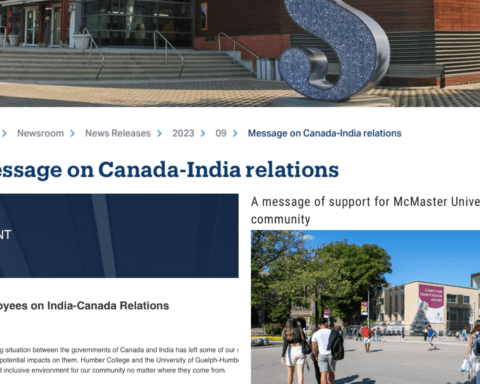India’s Prime Minister Narendra Modi will be in Canada later this month. He will be visiting Ottawa, Toronto and Vancouver in the first bilateral visit in four decades (though Prime Minister Manmohan Singh was in Toronto in 2010 for the G20 summit).
Since Prime Minister Stephen Harper’s visit to India in November 2012, there has been a significant change in relations between Canada and India.
Still, notwithstanding the good relations that our two countries have enjoyed and the many similarities between our institutions, trade and investment has remained subdued.
India’s needs and Canada’s capacities complement each other in an amazingly unique manner.
Presently, bilateral annual merchandise trade between Canada and India is $6 billion US, less than a 10th of the level of India’s trade with the United States and less than half of that with Australia.
However, India’s trade with Canada has been fast growing: by 77 per cent since 2010 and by 18 per cent in the first 10 months of 2014. And the potential for much larger volumes is definitely there.
‘Win-Win’ Situation
India’s needs and Canada’s capacities complement each other in an amazingly unique manner, underscoring a truly “win-win” situation.
India lacks hydrocarbons and steel grade coal. Canada has an abundance of both. India is a big consumer of pulses and Canada grows the stuff to meet part of India’s needs.
Canadian pulp and newsprint and potash find their way to India. Canada is a big market for the kind of goods that India manufactures for the export market – from apparel and fabric to carpets and leather articles.
For obvious reasons India would like to diversify its sources of crude oil supply. Canada represents a politically stable source and one that is barely tapped.
India and Canada also have huge complementarities in information technology, higher education and urban planning.
While there are well-regarded Indian companies in Canada and well-regarded Canadian companies in India along with some co-operation in the area of high technology – from nuclear energy to avionics to solar cells – these are still only the beginnings.
India offers a host of opportunities for Canada’s mature pension funds and insurance business. One half of the bilingualism of business and commerce in both countries is identical, i.e. English, and, of course, Canada is home to more than a million people of Indian origin.
Changing Petroleum Markets
But perhaps the lowest hanging fruit – and a pretty massive one at that – is oil and gas. India’s refineries processed 224 million tonnes of crude oil in 2014-15, a number that is likely to increase by five to 10 million tonnes each year for the next several years.
India imports most of its crude oil needs and in 2014-15 that was about 190 million tonnes, nearly 20 million tonnes more than in 2011-12. Most of the oil comes from the Middle East, while some is sourced from West Africa and about 17 per cent from Latin America – mostly Venezuela, but also Mexico, Colombia and Ecuador.
Supply from Canada was initiated last year. For obvious reasons, India would like to diversify its sources of crude oil supply. Canada represents a politically stable source and one that is barely tapped.
On the other hand, Canadian oil production, especially from the oil sands of Alberta, but also from offshore fields in the Atlantic, is bound to increase with the passage of time.
For Canada, the growing oil markets of Asia clearly represent the potential to create the income and employment opportunities that Canadians deserve.
The principal market historically, i.e. the U.S., has its own surging output. For Canada, the growing oil markets of Asia clearly represent the potential to create the income and employment opportunities that Canadians deserve.
In fact, the world’s petroleum (oil and gas) markets are undergoing a change in geography: even as the weight of production shifts westwards, the increments to demand moves to the east. More and more oil and gas will traverse the Atlantic and Pacific from the Americas and West Africa to markets in Asia.
But Canada has a logistical problem – its pipelines lie in the north-south axis well suited to service the traditional U.S. market, but unsuited to meet Asian markets.
None of the pipelines run to either the Atlantic or the Pacific coast. The TXL pipeline would have theoretically brought Canadian oil to the U.S. Gulf Coast, but that is on hold.
The Boost Canada Needs
Canada needs to build those pipelines that can link rich oil and gas fields to tidewater. For India, Canada’s east coast makes more logistical sense, while for East Asia the west coast would be convenient.
With new technology that has still to peak, more hydrocarbon potential will emerge in Canada’s provinces than previously believed.
A pipeline infrastructure that can take the product to ships on the east and west coasts is something that Canadians must commit to, for they understand their country better than overseas customers left to fill in the gaps in Canada’s pipeline infrastructure.
I hope Prime Minister Modi’s visit to Canada will, among other things, boost the prospect for our bilateral commercial ties in the area of oil and gas.
Just as I am sure Indian refiners would like to tank up on Canadian crude, I am sure that Indian investors would be open to taking stakes in gas liquefaction facilities if Canadian natural gas can be delivered there.
Indian Oil has already taken a multi-billion dollar stake in a gas project in British Colombia, and the magic of working closer together will help facilitate greater levels of profitable and mutually beneficial co-investment in developing Canada’s rich oil and gas resources.
Saumitra Chaudhuri is a Senior Fellow with the Asia Pacific Foundation of Canada, and a former member of the Economic Advisory Council to the Prime Minister of India.




